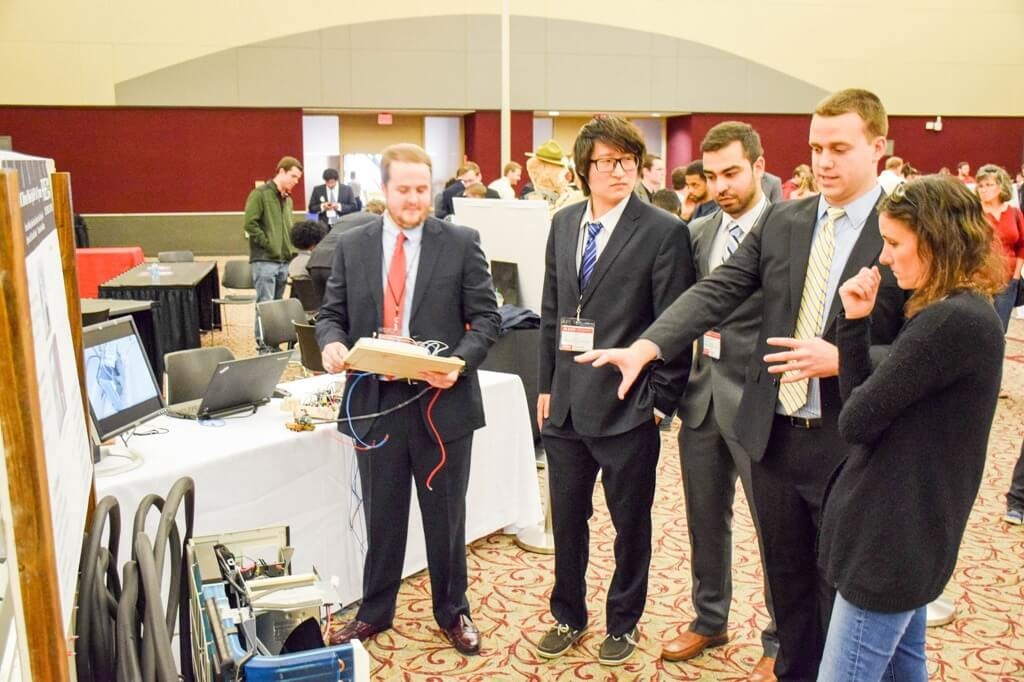
Senior Design Day demonstrates Innovation and Creativity
On Friday, December 2, 2016, NC State Seniors in Electrical and Computer Engineering revealed their prototypes at Engineering Design Day. Four individual competitions were held, one for project proposal of in-progress projects (which will be prototyped …
December 8, 2016 ![]() cjbrown8
cjbrown8
On Friday, December 2, 2016, NC State Seniors in Electrical and Computer Engineering revealed their prototypes at Engineering Design Day. Four individual competitions were held, one for project proposal of in-progress projects (which will be prototyped in the Spring) and three for full-scale prototypes of finished projects.
“We learned a lot about circuit components and mechanical aspects when it comes to computers,” explained Taylor Hill, of the Lab Programmable Power Supply team. “You hear fans, you see filters, but really, what does it mean and how do they work? We had the opportunity to learn a lot about that.”
NC State Senior Design Projects, many of which sponsored by outside companies and organizations, are highly anticipated and critically acclaimed once completed. A noteworthy project from 2015 was the Infinity Cube for North Carolina Museum of Arts Exhibit. The team combined two-way mirrors, LEDs, sensors and a micro-controller creating captivating patterns and effects. The Infinity Cube was on display at the museum prior to returning to NC State, now on display outside the ECE administration offices.

The ECE Senior Design experience is a two semester course (ECE 484\ECE 485) designed to prepare students for the workplace through hands on experience in the design and development of a real world solution. Students learn about the product life cycle and about development processes utilizing system engineering and project management techniques. “One of the most important parts of project management is time management,” recalled Connor Tripp, from the GaN Coffee Roaster team, “because if you can manage your time well and plan ahead, any problems that come up, you have them accounted for.”
Working in teams, students start with a problem statement, then define product requirements, evaluate possible solutions and perform design trade-off analyses. They proceed to then define a system solution, develop a project plan, and share a presentation of their system design and plan at a design review. Students complete their detailed design and then build a working prototype to verify their solution.
“There’s no commercially-available products involved [in our project], we developed everything ourselves. We had to come together, brainstorm, and agree on what features we wanted. We’re proud of our accomplishment,” extolled James Staley, discussing their Lab Programmable Power Supply.
The teams present, and are judged on their prototype solutions at Engineering Design Day. Finally, students document their design process and solution in a final report, which also includes a summary of lessons learned and possible future enhancements – some of which become future Senior Design projects themselves.
The results from the competition for the final projects from ECE 485 are:
Energy Efficiency & Controls:
1st: Project 11: Lab Programmable Power Supply
2nd: Project 10: Power America-GaN Coffee Roaster
3rd: Project 1: Outlet Monitoring and Control
Health & Public Service:
1st: Project 8: ASSIST-Exhaled NO2 Monitor
2nd: Project 3: Big Smokey Bear Rebuild
3rd: Project 14: Car Rider Line Management System
Internet of Things (IoT) & Software
1st: IoT Missing Child Finder (Facial Recognition)
2nd: Project 05: Contextual Aware Service in IoT
3rd: Project 7: International Darth Vader
From the projects that are in progress (ECE 484), five projects were awarded for their posters and project proposals:
1st: Digital Professional Instructor for Training and Rehabilitation
2nd: Wireless Plant Growth Monitoring
3rd: Light up Garment for Nighttime Runners
4th: Auto Scorer for Cornhole Game
5th: FREEDM Water Heater Load Demo
